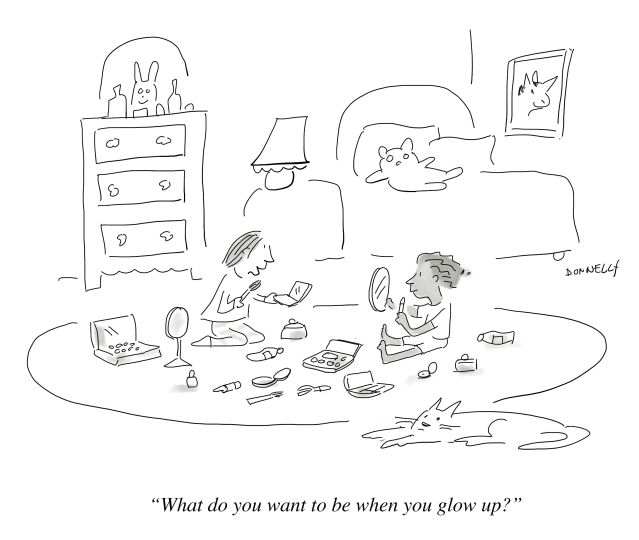Beauty
The Problem With the Glow Up
Attempts to critique beauty culture can’t seem to shake the power of…beauty culture.
Updated October 4, 2024 Reviewed by Tyler Woods
The newly released Netflix movie, Uglies, based on a 2005 book series, is about the perils of a society that is premised on artificially-created flawlessness (in a pore-less, uncanny valley, Instagram filter kind of way). Remarkably skirting the extent to which our cultural beauty norms disproportionately impact girls and women, Uglies defines beauty as a faux-utopian ideal. A perfect appearance is achieved by mandated scientific/magical/surgical means at the tender age of 16 and is accompanied by lobotomized obedience and vapid acceptance of the status quo. The resistance movement that this rule of law predictably inspires aims to return to a simpler time when people aged naturally, grew their own food, and exchanged goods instead of money.
One major flaw in the primary conceit, besides retracing the false dichotomy of brains vs. beauty, is, as a reviewer for the New York Times aptly ended her piece: “viewers can’t help but notice that the rebels are also naturally telegenic” (on point: the actor portraying the young male leader of the resistance movement apparently started his career as a model).
The same problem runs through a grittier attempt to critique the existential threat that older women feel when their looks render them culturally obsolete (i.e., at 50). The central conceit of Demi Moore’s “body horror” film, Substance, is also a sci-fi-infused beauty fantasy: a potion can be used to hatch (literally) a flawless younger version of the self. The two versions of one consciousness take turns being out in the world. A murderous battle for time on earth/in the spotlight ensues. Reviewers have been divided over just how much useful feminist commentary runs through the too-gory-for-this-blogger-to-watch film, but a couple have noted a distracting detail: “My inability to suspend my disbelief may be in part because Demi Moore, who plays faded star Elisabeth Sparkle, is one of the most beautiful 62-year-olds on the planet.”
Another reviewer asked, “Here, she convincingly plays a 50-year-old, but she might easily pass for still 10 years younger than that. What elixir has she been taking, we might wonder.”
[For a more comedic take on Hollywood’s treatment of older women and the double standards they face, see Amy Schumer’s version.]
It is unfortunate that well-intentioned attempts to critique beauty ideals end up reproducing, at least in part, the very standards they seek to debunk. Perhaps this in itself is a powerful form of commentary; we keep trying to break free of the beauty myth, but it keeps pulling us back in.
The same kind of circular logic pervades social media with “body positive” content relying primarily on the same old images of Western beauty ideals and failing to mitigate the body anxieties of their target audiences. Take the recent phenomenon of “glowing up” (which a student had to explain to me last year)—an ostensibly holistic approach to optimizing one’s life that nevertheless keeps the focus on outward appearances. As one “wikihow” informs us: Whatever your glow up means to you, it’s all about becoming the best version of yourself and learning to practice self-care and acceptance! And what is Step 1 in putting your own stamp on what it means to feel confident and accepted? “Change your appearance.” Instructions that follow focus on changing your skin care regimen, your posture, your clothing, and your hair.
Similarly, a popular YouTuber admitted to her 1.5 million followers, in a segment entitled How to Actually Glow Up, which has 3.9 million views: “I thought that I was doing self-care, but I was just trying to fit into the beauty standards; at some point the question came up, am I trying to look better or feel better?” She listed the physical toll that anxiety about living up to societal standards can take on one’s appearance, from thinning hair to dull skin, and concluded that you need to work on the “mental aspect, not just the physical.” Moments later, she offers her prescription for “physical self-care” because “When you look good, you feel good” and offers: “Number 1. Invest in your skincare and haircare.” And we’re back to square one.
**This is not to suggest that all YouTubers who focus on their appearance are necessarily contributing to a toxic beauty culture. As scholars have noted, sometimes it can be quite the opposite as young women of color navigate beauty norms that cut against dominant/White ideals.**
Human beings are incredibly adept at assessing what is valued in their social environment—at noticing who receives implicit (attentional focus) or explicit (money) rewards. Social cognitive theory (Bandura, 2001) cautions that media exerts its influence not because we are motivated to passively mimic what we see, but because we make strategic and ostensibly adaptive decisions. We look around us and attune to which behaviors and appearances will gain approval or success, as well as which images and messages are self-relevant and which are not. The latest trend of young girls packing the aisles at Sephora beauty stores, asking their parents to buy them expensive lotions and make-up, highlights the ongoing impact of appearance-based media culture. (Here’s a student perspective that illuminates the irony of social media influencers lamenting the impact their own posts helped create.)
So, it is not necessarily that media consumers just need to wake up and stop imprinting on unrealistic expectations, but rather that media images and messages need to stop glorifying the same old unattainable beauty standards. As long as A-list celebrities and social media influencers who attempt to critique the beauty myth don’t actually disengage from it themselves, young girls and women, and indeed boys and men, will not get the message.

References
Bandura, A. (2001). Social cognitive theory of mass communication. Media Psychology, 3(3), 265-299.
Many thanks to Liza Donnelly for her original cartoon and to Vassar students Bianca Niyonzima and Tallulah Rector for their helpful insights.


